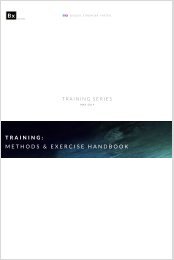Create successful ePaper yourself
Turn your PDF publications into a flip-book with our unique Google optimized e-Paper software.
HTKSPORT<br />
FOREWORD<br />
This Series is about Strength Training; not necessarily how to get stronger in the<br />
traditional sense (for example - squatting more weight), but more specifically some<br />
fundamentals about how to train to get better at any sport. Strength – defined in<br />
many different ways specific to many different physical actions and desired<br />
performances – is the foundation of physical activity and therefore sports<br />
performance.<br />
This is not your typical strength training book. The focus of this Series is Athletic<br />
Strength. Athletic Strength is not about getting better at lifting heavy weights; Athletic<br />
Strength is about developing ‘ALL WEATHER ATHLETES.’ That is - athletes that are big,<br />
strong, and fast on the field or court. The All Weather Athlete is defined by the ability<br />
to excel in every facet of physical performance.<br />
These athletes are not built under barbells. Weight training is a tool, useful in many<br />
ways but unless the goal is to get better at lifting heavy weights, traditional heavy<br />
barbell training should be used very strategically; it should be used from a paradigm<br />
of eliciting desired neural responses, rather than contractile strength or mechanical<br />
improvement. This book is about building better athletes, not workout warriors.<br />
So, what is the focus of this book? This book is about the production and efficient<br />
utilisation of force. Athletic performance is rarely determined by pure strength; those<br />
who win are those who can produce more force in less time. The ability to exert more<br />
force in less time is function of being able to produce a lot of force, neural/neuromuscular/myo-facial/muscular<br />
strength qualities, being able to access and utilise<br />
them quickly, being able to transmit force efficiently, create a stable base from which<br />
it can be transferred, and a whole range of other factors explored in this book.<br />
JUNE 2018 | ISSUE 01<br />
Force production is a function of an athlete’s ‘engine;’ strength is simply the body’s<br />
structural ability to transmit and potentiate the force a particular neural output<br />
creates. Strength therefore refers to neural efficiency and structural suitability. Speed<br />
and explosiveness are primarily a result of executing reflexive neuro-muscular loops<br />
on a foundation of myofascial strength and power – ‘strength’ here refers to an<br />
efficiency of force transmission and transference, which a structural adaptation to<br />
explosive neural output. The human body is an adaptive machine, and the internal<br />
and external structures will adapt to the demands of the internal engine.<br />
x




